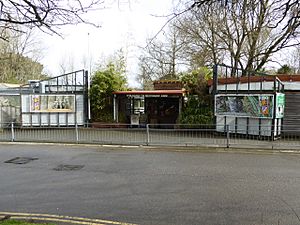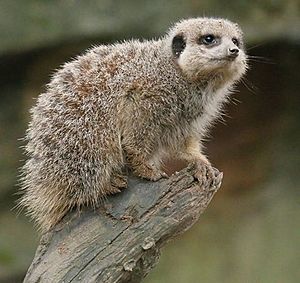Newquay Zoo facts for kids
 |
|
| Date opened | 26 May 1969 |
|---|---|
| Location | Newquay, Cornwall, England |
| Land area | 13 acres (5.3 ha) |
| Coordinates | 50°24′48″N 5°04′20″W / 50.41341°N 5.07214°W |
| No. of species | Over 130 |
| Major exhibits | Tropical House, Gems of the Jungle, Village Farm |
| Website | http://www.newquayzoo.org.uk/ |
Newquay Zoo is a cool place where you can see lots of different animals! It's located in Newquay, England, inside the Trenance Leisure Park. The zoo first opened its doors on May 26, 1969. For a while, it was privately owned, but since August 2003, it has been part of the Whitley Wildlife Conservation Trust. This trust also runs Paignton Zoo and Living Coasts.
Newquay Zoo is a registered charity, which means it works to help animals and nature. It has won many awards for being a great place to visit and for its efforts in sustainable tourism. Today, the zoo is managed by the Wild Planet Trust, which is the new name for the Whitley Wildlife Conservation Trust.
Contents
Helping Our Planet
Newquay Zoo is known for being very eco-friendly. It was one of the first zoos in Britain to get a special certificate called ISO 14001 for how well it manages its environmental impact. It also has a Gold award from the Green Tourism Business Scheme.
The zoo works with other zoos in Britain and Europe through groups like BIAZA and EAZA. They also help with conservation projects in other countries. For example, the zoo helped create an interactive map of Newquay. This map encourages people to walk around town and learn about its history, wildlife, and how to use public transport. This project even won an award for being sustainable!
Newquay Zoo Today
Newquay Zoo is the biggest zoo in Cornwall. It covers more than 13 acres of land. When it first opened, it was only about 6 acres! The zoo is home to over 130 different kinds of animals.
In 2009, the zoo added a new area called the African Savanna. Later, they opened a special area for animals from the Philippines. This area helps protect endangered animals like the fishing cat, Visayan warty pig, and Philippine spotted deer.
Amazing Animals
The zoo has many animals, and some are part of special breeding programs. These programs help increase the numbers of endangered species. Some of these animals include red pandas, lemurs, Humboldt penguins, marmosets, tamarins, and tapirs.
Newquay Zoo is also part of international efforts to save animals like Owston's palm civets. They support projects that help these animals in their natural homes. They also help projects for sloths and pacaranas in South America, and pangolins in Southeast Asia. The zoo supports the World Land Trust too, which protects wild spaces.
Many of the animals you see at Newquay Zoo are listed as threatened or endangered species by the IUCN. This means they need our help to survive in the wild.
- Mammals
- Asian small-clawed otter
- Azara's agouti
- Black-and-white ruffed lemur
- Black wildebeest
- Brazilian guinea pig
- Capybara
- Carpathian lynx
- Chapman's zebra
- Colombian white-faced capuchin
- Coppery titi
- Crowned lemur
- Dusky pademelon
- Fishing cat
- Goeldi's marmoset
- Gray slender loris
- Hoffmann's two-toed sloth
- Impala
- Long-nosed potoroo
- Meerkat
- Nyala
- Owston's palm civet
- Parma wallaby
- Prevost's squirrel
- Pygmy marmoset
- Red panda
- Ring-tailed lemur
- Silvery marmoset
- Six-banded armadillo
- South American tapir
- Swinhoe's striped squirrel
- Visayan spotted deer
- Visayan warty pig
- Yellow mongoose
- Birds
- Asian fairy-bluebird
- Black-necked swan
- Blue-crowned hanging parrot
- Blue-crowned laughingthrush
- Great white pelican
- Greater vasa parrot
- Grosbeak starling
- Humboldt penguin
- Indian peafowl
- Javan green magpie
- Lilacine amazon
- Luzon bleeding-heart
- Papuan hornbill
- Pink-headed fruit dove
- Scarlet macaw
- Snowy owl
- Sumatran laughingthrush
- Herps
- Amazon milk frog
- Black tree monitor
- Electric blue gecko
- Fiji banded iguana
- Panther chameleon
- Radiated tortoise
- Red-tailed racer
- Invertebrates
- Curlyhair tarantula
Recent Zoo Changes
Since 2009, the zoo has made some exciting changes. They added a large new area called the African Savanna. This space is perfect for African hoofstock, which are animals with hooves.
The old African Plains exhibit was then changed into a home for endangered Philippine island animals. These include the Philippine spotted deer, Visayan warty pigs, and fishing cats.
In 2016, a new walkthrough aviary called Gems of the Jungle was built. This aviary is home to endangered songbirds from Southeast Asia. It replaced an older bird house from 1969.
Fun Things to Do
At Newquay Zoo, you can often watch animal encounters and listen to talks during feeding times. There's also a fun Tarzan Trail adventure course and Children's Play Areas. In the past, there was even a Dragon Maze, which was a hedge maze designed by Adrian Fisher. These features make the zoo a great place for kids to explore and play!
Learning and Education
Newquay Zoo works with other groups on special events and educational projects. For example, in 2009, they celebrated the 200th birthday of Charles Darwin. They even partnered with Falmouth Art Gallery to show art inspired by Darwin's journey.
Since 2000, the zoo has also helped students from Cornwall College Newquay. These students learn about animal conservation, education, and media. The college campus is right next to the zoo, making it a unique place to study. This partnership has won awards for its great education programs.


